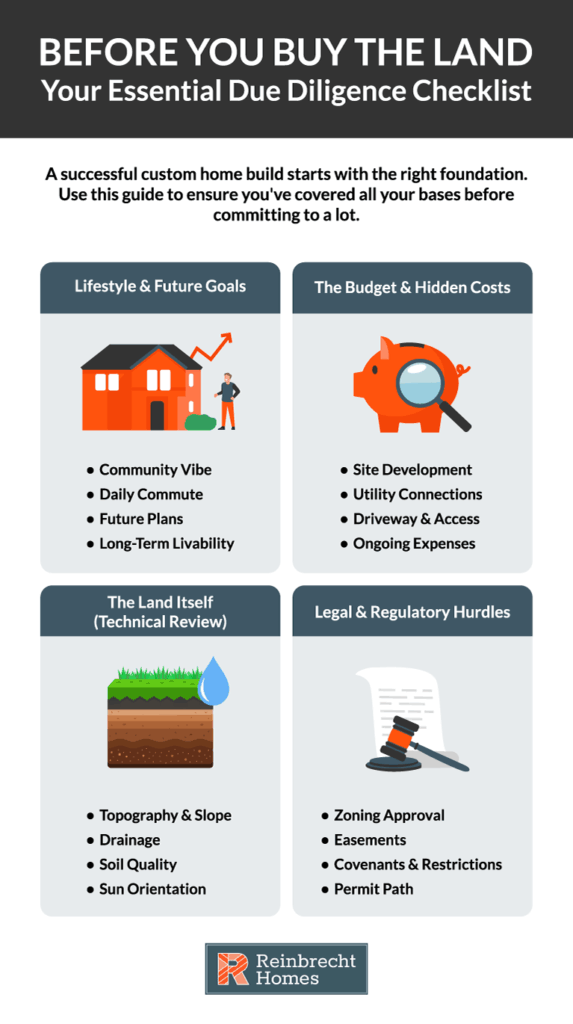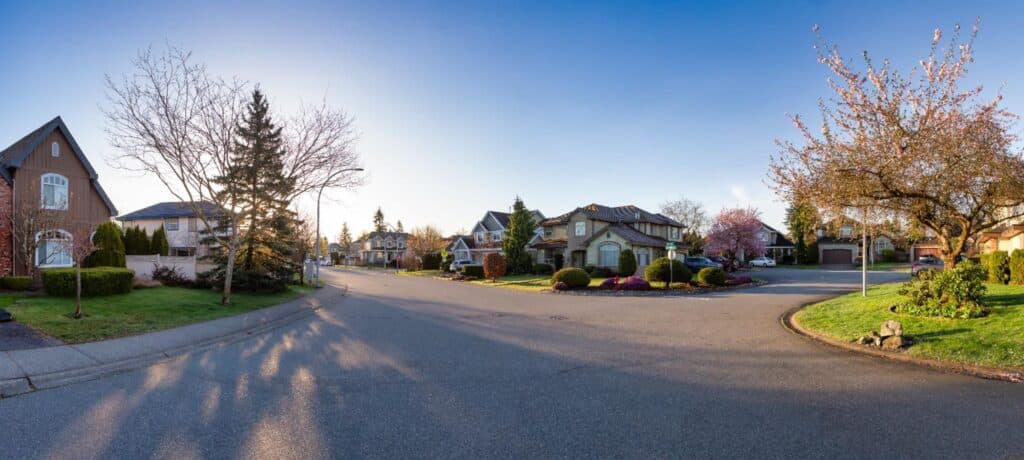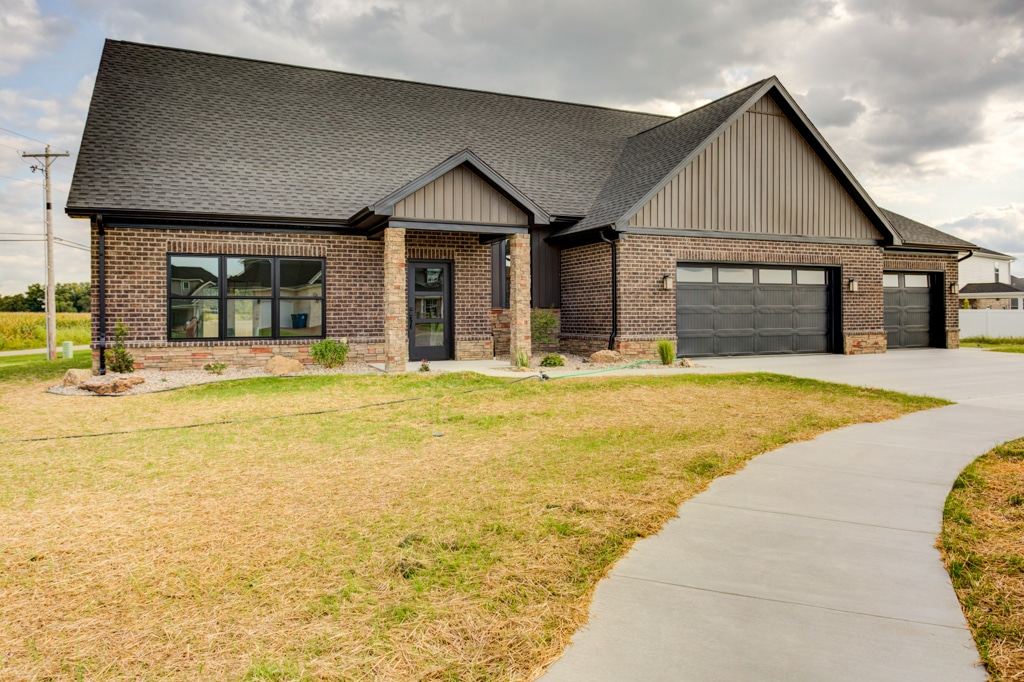The decision to build a custom home is the start of a remarkable journey. It’s an opportunity to translate your vision into a physical space that will shape your family’s life for years to come. For those embarking on this path in the diverse landscapes of Southern Indiana and Eastern Illinois, the single most important decision you will make is the very first one: choosing the right piece of land.
The perfect site is far more than a backdrop for your house; it is the true foundation of your future. A strategic choice can enhance your daily convenience, secure your financial investment, and ensure a smooth construction process. Conversely, an ill-suited lot can lead to unforeseen costs, frustrating delays, and long-term dissatisfaction. This comprehensive guide, designed for those building, will provide the detailed custom homebuilding tips you need to navigate this critical process with confidence, ensuring the ground beneath your dream home is as solid as its foundation.


Step 1: The Vision – Defining Your Personal, Family, and Lifestyle Needs
Before you analyze a single property listing, you must first analyze yourself. The land must serve your life, not the other way around. This initial “vision phase” is crucial for creating a filter that will immediately eliminate unsuitable properties.
Community Atmosphere: What is Your Ideal Environment?
The character of your surroundings profoundly influences your daily experience. Consider the distinct feels of different environments:
- Vibrant Suburban: These communities often feature planned developments, sidewalks, nearby parks, and a strong sense of neighborhood. They offer convenience to shopping and schools but may come with smaller lot sizes and the rules of a Homeowners’ Association (HOA).
- Charming Small Town: Locations like those found throughout Southern Indiana offer a quieter pace of life, often with historic town squares, local businesses, and a tight-knit community feel. You may find larger lots than in the suburbs, but with fewer immediate amenities.
- Rural Seclusion: For those seeking privacy, space, and a connection to nature, a rural lot offers unmatched potential. This choice provides the most freedom but often requires the most extensive planning for utilities, access, and longer travel times to services.
Proximity and Practicality: Charting Your Daily Life
Think about the travel patterns of your household. A beautiful, remote property can quickly lose its charm if it adds an hour to everyone’s daily commute. Make a list and rank the importance of proximity to:
- Workplaces
- Schools (research the quality of the local school district)
- Healthcare facilities (hospitals and clinics)
- Grocery stores and shopping centers
- Recreational outlets (parks, hiking trails, sports facilities)
- Family and friends
Future Growth and Flexibility
Your life in the future will be different from your lifestyle today. Your property should have the flexibility to adapt. Consider long-term plans such as:
- Home Expansions: Do you foresee adding a new wing, a sunroom, or a second story?
- Outdoor Features: Is there room for a future swimming pool, a large vegetable garden, a workshop, or a guesthouse?
- Aging in Place: Will the terrain and home design be suitable for you as you get older?
By the end of this step, you should have a detailed written brief outlining your ideal location. This document will become your compass for the entire search process.
Step 2: The Financial Blueprint – Budgeting Beyond the Land Price
A common mistake in custom homebuilding is underestimating the total cost associated with a piece of land. Your “all-in” budget must account for far more than the sticker price.
Understanding Land Costs and Their Variables
The price of a lot is determined by location, desirability, and level of development. In suburban areas, a premium is paid for accessibility and ready-to-build infrastructure. In rural areas, prices can be driven up by unique features like waterfront access, mature woodlands, or scenic views. Consulting with local real estate experts and builders is the best way to gauge realistic costs in specific areas.
The Hidden Costs of Site Development
This is where budgets are most often broken. An undeveloped, “cheaper” lot can quickly become more expensive than a developed one once you factor in site prep. Be sure to get estimates for:
- Utility Connections: Extending public water, sewer, natural gas, and electricity to your homesite can cost tens of thousands of dollars, often priced per foot from the nearest main line.
- Well and Septic Systems: If public utilities aren’t available, you will need to budget for drilling a well and installing a septic system, which requires a successful percolation test to ensure the soil can handle drainage.
- Driveway Installation: The cost of creating a long driveway on a rural lot, from grading and gravel to final paving, can be substantial.
Land Clearing and Grading: Removing trees and leveling a building pad for the foundation is a significant expense.
Evaluating Long-Term and Ongoing Expenses
Your financial commitment continues long after the purchase. Research these recurring costs:
- Property Taxes: Rates can vary significantly between neighboring towns and counties. Look up the specific tax rates on the county assessor’s website before making an offer.
- Homeowners’ Association (HOA) Fees: If you’re in a planned community, get a copy of the HOA budget. These fees can range from minimal to substantial and cover amenities like pools, road maintenance, and landscaping.
- Homeowner’s Insurance: A property located in a designated flood plain or an area with high wildfire risk will have significantly higher insurance premiums.
Step 3: Technical Due Diligence – Inspecting the Land Itself

Once you have a specific site in your crosshairs, it’s time to become a detective. These technical factors will determine if the land is truly viable for your project.
Topography, Drainage, and Flood Risk
The slope and shape of the land dictate foundation design, driveway placement, and water management.
- Topography: A gentle slope is ideal. A steep slope may require expensive retaining walls and a more complex foundation. Walk the entire property to understand its contours.
- Drainage: Observe the land after a heavy rain. Where does water flow and where does it pool? Poor drainage can lead to a perpetually wet basement and foundation issues. You want to see water flowing naturally away from your proposed homesite.
- Flood Risk: Reviewing local flood maps allows you to avoid flood-prone areas. This precaution can help manage insurance costs and protect your investment.
Soil and Geological Conditions
What lies beneath the surface is just as important as what you see on top. A professional geotechnical engineer can perform a soil test, which involves taking core samples (soil borings) to assess:
- Load-Bearing Capacity: Can the soil safely support the weight of your home?
- Soil Composition: Expansive clay soils, common in some regions, can swell and shrink with moisture changes, putting immense stress on a foundation.
- Rock Ledges: Hitting a large underground rock ledge during excavation can drastically increase foundation costs.
Sun Exposure and Orientation
The orientation of the lot relative to the sun has a massive impact on your home’s energy efficiency and ambiance. With your architect, you can position the home to:
- Maximize Winter Sun: Place large windows on the south-facing side of the home to capture passive solar heat in the winter.
- Minimize Summer Heat: Use smaller windows, roof overhangs, and deciduous trees on the west-facing side to block the intense afternoon sun in the summer.
Step 4: Navigating Regulations, Permits, and Legal Restrictions

You can’t just build whatever you want, wherever you want. Every property is subject to a web of legal constraints that you must uncover before you buy.
Zoning Laws and Building Codes
Contact the local planning and zoning department to confirm that a single-family residence is a permitted use for the property. Building codes will dictate the minimum structural and safety standards your home must meet.
Easements, Covenants, and Deed Restrictions (CRUCIAL)
This is a critical, often-overlooked area of due diligence.
- Easements: These are legal rights granted to another party to use a portion of your property. A common example is a utility easement, allowing the power company to access lines running across your backyard. An access easement might grant a neighbor the right to use your driveway to get to their property. These can severely restrict where you can place your home, a pool, or even a fence.
- Covenants and Restrictions: In many subdivisions, a set of rules called “Covenants, Conditions, and Restrictions” (CC&Rs) are written into the deed. These can govern everything from the minimum square footage of your home and the types of exterior materials you can use to whether you can park an RV in your driveway or the types of pets you can own.
You can uncover these by obtaining a copy of the property’s title report and plat map. A real estate attorney can be invaluable in helping you interpret these documents.
Step 5: Future-Proofing for Long-Term Value
Integrating forward-thinking design and technology will enhance your quality of life and protect your investment.
- Embracing Sustainability: Plan for energy efficiency from the start. This includes proper orientation, high-performance windows, and infrastructure for future additions like solar panels (installing conduits from the roof to the utility room is cheap during construction, but expensive later) and rainwater harvesting systems.
- Integrating Smart Home Technologies: A truly smart home needs a strong backbone. Plan for structured wiring, running Cat6 Ethernet cables and coaxial cables to key rooms. This provides reliable connectivity for smart systems, home offices, and entertainment. Plan for the placement of electric vehicle chargers in the garage.
Reinbrecht Homes: Simplifying the Homebuilding Process
Reinbrecht Homes is a premier custom home builder in Southern Indiana and Eastern Illinois, offering a comprehensive suite of services that simplifies the homebuilding process. Our mission is to help you find the best lot for your dream home, taking into account all the critical factors that impact your building experience and your long-term satisfaction. With over 30 years of experience in the industry, we offer the following benefits for your custom home project:
- Comprehensive Knowledge: Expertise in Southern Indiana and Eastern Illinois terrain helps select the ideal site for your dream home.
- Custom Design Services: Tailored architectural plans align with your lifestyle and aesthetic preferences.
- Integrated Project Management: Coordinated services from permitting to construction, ensuring timely and within-budget project completion.
- Quality Craftsmanship: Dedication to high standards of construction, using top-grade materials and innovative building techniques.
- Sustainable Solutions: Incorporating energy-efficient and eco-friendly practices to future-proof your home.
- Transparent Budgeting: Clear financial guidance helps manage costs with realistic estimates for every phase of the build.
- Ongoing Support: Dedicated customer service before, during, and after your home is built, providing a personalized experience.
By partnering with Reinbrecht Homes, you ensure a smoother transition from vision to reality, creating a space that reflects your unique aspirations and needs.
A Foundation for a Rewarding Future
Choosing the ideal site for your custom home is an intricate dance that balances dreams with due diligence. It requires you to be a visionary, a financial planner, a detective, and a futurist. By following a methodical process—from defining your lifestyle needs and establishing a comprehensive budget to conducting thorough technical and legal research—you transform a daunting task into a series of manageable steps.
This meticulous planning is the true cornerstone of your project. A carefully chosen site in Southern Indiana or Eastern Illinois is the key that unlocks a home that not only reflects your unique style but also stands the test of time, providing comfort, security, and joy for decades to come.
Ready to start building the foundation of your future? Contact Reinbrecht Homes for expert, personalized guidance on selecting the perfect site and launching your custom homebuilding journey.

